Susan Powers | |
|---|---|
| Born | 1954 (age 69–70) Glen Cove, New York, U.S. |
| Alma mater | University of Vermont |
| Occupation | Artist |
Susan Powers (born 1954 in Glen Cove, New York) is a self-taught American artist.
Susan Powers | |
|---|---|
| Born | 1954 (age 69–70) Glen Cove, New York, U.S. |
| Alma mater | University of Vermont |
| Occupation | Artist |
Susan Powers (born 1954 in Glen Cove, New York) is a self-taught American artist.
Powers attended the University of Vermont, where she studied classical languages and medieval history, graduating in 1976 with a Bachelor of Arts degree in European Studies.
Powers began painting in 1979, encouraged by a friend and fellow painter who had seen her expressive pencil drawings. Only a year later, her work had been accepted for display by the prestigious Jay Johnson Folk Heritage Gallery in New York City. In 1980, Powers spent a year in England and France developing her craft, before returning to the U.S.
The folk art still lifes of Susan Powers have been compared with the trompe-l'œil works of the well-known 19th-century American academic artist William Harnett. Like Harnett, Powers is fascinated with common everyday objects—books, seashells, bottles, and teapots—and she renders them in a manner so lifelike they ‘fool the eye’ of the viewer, almost leading the viewer to believe that the objects themselves are present on the canvas. The trompe-l'œil technique is uncommon with folk artists: some folk artists cannot produce a photograph-like image.
Her paintings are in many permanent collections, including the Smithsonian Institution in Washington, D.C., and the American Museum in Bath, England. Her works have been exhibited in numerous museums, including the Bede Gallery, Jarrow, England, the Woodspring Museum, Weston-super-Mare, England, the Camden Arts Center, London, the Haworth Art Gallery, London, and at the White House in Washington, D.C.

” The still lifes of Susan Powers have been compared
with the trompe-l'œil works of the well-known 19th–century
American academic artist William Harnett. Like Harnett,
Powers is fascinated with common everyday objects—
books seashells, bottles, and teapots—and she
renders them in a manner so lifelike they ‘fool the eye’
of the viewer, almost leading the viewer to believe that the
objects themselves are present on the canvas. The
trompe-l'œil technique is uncommon with folk artists:
some folk artists cannot produce a photograph-like image...”
American Folk Art of the Twentieth Century
Jay Johnson & William C. Ketchum Jr.
(Rizzoli International, New York, NY 1983)
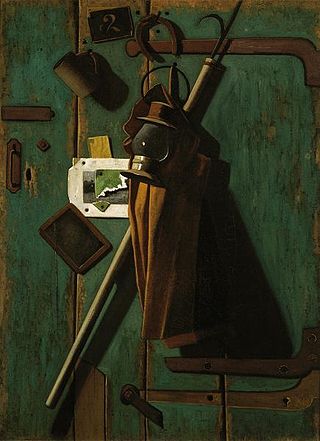
John Frederick Peto was an American trompe-l'œil painter who was long forgotten until his paintings were rediscovered along with those of fellow trompe-l'œil artist William Harnett.
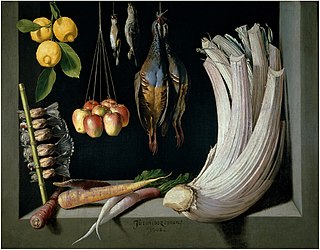
A still life is a work of art depicting mostly inanimate subject matter, typically commonplace objects which are either natural or human-made.
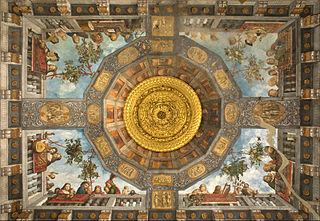
Trompe-l'œil is an artistic term for the highly realistic optical illusion of three-dimensional space and objects on a two-dimensional surface. Trompe l'œil, which is most often associated with painting, tricks the viewer into perceiving painted objects or spaces as real. Forced perspective is a related illusion in architecture.
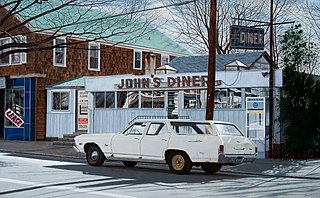
Photorealism is a genre of art that encompasses painting, drawing and other graphic media, in which an artist studies a photograph and then attempts to reproduce the image as realistically as possible in another medium. Although the term can be used broadly to describe artworks in many different media, it is also used to refer to a specific art movement of American painters that began in the late 1960s and early 1970s.
Otis Kaye (1885–1974) was an American artist during the early 20th century. He is noted especially for trompe-l'œil paintings of U.S. currency.
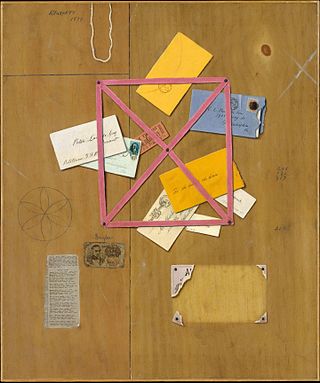
William Michael Harnett was an American painter known for his trompe-l'œil still lifes of ordinary objects.
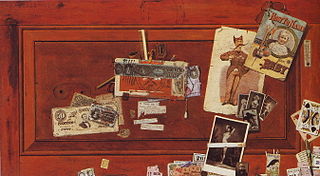
John Haberle (1856–1933) was an American painter in the trompe-l'œil style. His still lifes of ordinary objects are painted in such a way that the painting can be mistaken for the objects themselves. He is considered one of the three major figures—together with William Harnett and John F. Peto—practicing this form of still life painting in the United States in the last quarter of the 19th century.

Louis-Léopold Boilly was a French painter and draftsman. A creator of popular portrait paintings, he also produced a vast number of genre paintings documenting French middle-class social life. His life and work spanned the eras of monarchical France, the French Revolution, the Napoleonic Empire, the Bourbon Restoration, and the July Monarchy. His 1800 painting Un Trompe-l'œil introduced the term trompe-l'œil, applied to the technique that uses realistic imagery to create the optical illusion that the depicted objects exist in three dimensions, though the "unnamed" technique itself had existed in Greek and Roman times.

Jefferson David Chalfant was an American painter who is remembered mostly for his trompe-l'œil still life paintings.

Cornelis Norbertus Gijsbrechts or Gysbrechts was a Flemish painter who was active in the Spanish Netherlands, Germany, Denmark and Sweden in the second half of the seventeenth century. He was a court painter to the Danish royal family. He specialised in trompe-l'œil still lifes, an artistic genre which uses visual tricks to give viewers the illusion that they are not looking at a painting but rather at real three-dimensional objects. He also created many vanitas still lifes.
Henri Cadiou was a 20th-century French realist painter and lithographer, best known for his work in trompe-l'œil painting. His trompe-l'œil paintings feature large groups of everyday objects depicted in a realistic style. He was also a painter of genre scenes.
Mary Shelley is an American folk artist with no formal visual art training. Her art work has variously been described as naïve, primitive or self-taught. She graduated from Cornell University in 1972 with a degree in English and Creative Writing, and has lived her entire adult life in Ithaca, NY. She began making her painted low relief woodcarvings in 1974, after her father sent her a painted woodcarving that he made of Shelley as a child at the family farm. Shelley worked as a sign painter and carpenter from 1973 to 1990, and learning these trades helped her to develop woodworking and design skills important to her evolution into a visual artist.

U.S.A. is a trompe-l'œil oil painting by American artist John Haberle from 1889, located in the Indianapolis Museum of Art, which is in Indianapolis, Indiana. It depicts currency and stamps so realistically that Haberle was accused of pasting real money to the canvas.
Sylvia Hyman was an American ceramic artist, art teacher and visual artist. She was known for her lifelike ceramic pieces and sculptures which are included in the collections of museums worldwide. Her trademark pieces, which were fashioned from stoneware or porcelain, often used the artist technique of trompe-l'œil to create the realism of art. Much of Hyman's work featured everyday objects, such as paper, books, or food, realistically crafted from ceramic. She was also the founder of the Tennessee Association of Craft Artists (TACA).
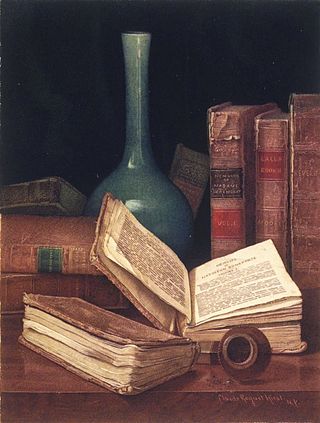
Claude Raguet Hirst was an American painter of still lifes. She was the only woman of her era to gain acclaim using the trompe-l'œil technique.
Richard Shaw is an American ceramicist and professor known for his trompe-l'œil style. A term often associated with paintings, referring to the illusion that a two-dimensional surface is three-dimensional. In Shaw's work, it refers to his replication of everyday objects in porcelain. He then glazes these components and groups them in unexpected and even jarring combinations. Interested in how objects can reflect a person or identity, Shaw poses questions regarding the relationship between appearances and reality.
Gary T. Erbe is an American oil painter. He is self-taught, and he is best known for his trompe-l'œils. His work has been exhibited at the Canton Museum of Art, the Brinton Museum, the Boca Raton Museum of Art, the Heckscher Museum of Art, the Baum School of Art and the Reading Public Museum.

The Reverse of a Framed Painting is a still life trompe-l'œil painting by Flemish painter Cornelius Norbertus Gysbrechts, made in 1670, when the artist was working as the official painter of the Danish royal court. The painting is commonly considered a masterpiece of trompe-l'œil painting for its deceptively sculptural representation of the back of a framed painting in a canvas.

Pitcher and Violin is an oil-on-canvas painting by the French artist Georges Braque, created in 1909–10. It was made at the beginning of the development of what would be analytical cubism. The painting is held in the Kunstmuseum, in Basel.
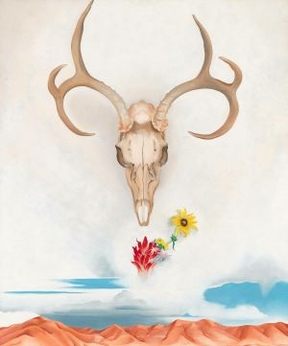
Summer Days is a 1936 oil painting by the American 20th-century artist Georgia O'Keeffe. It depicts a buck deer skull with large antlers juxtaposed with a vibrant assortment of wildflowers hovering below. The skull and flowers are suspended over a mountainous desert landscape occupying the lower part of the composition. Summer Days is among several landscape paintings featuring animal skulls and inspired by New Mexico desert O'Keeffe completed between 1934 and 1936.